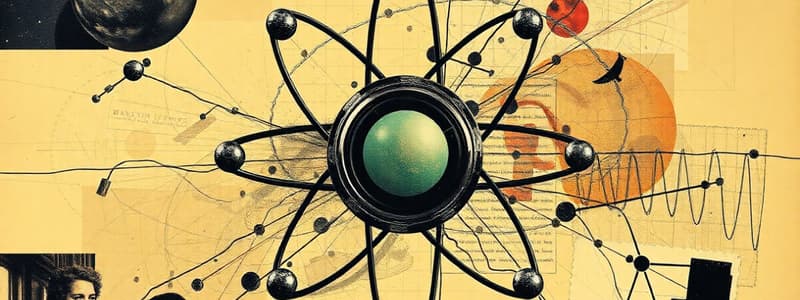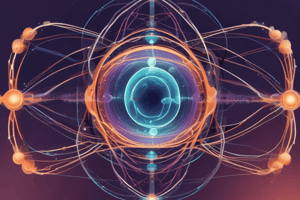Podcast
Questions and Answers
What happens to the electric force between two similar charges as the distance increases?
What happens to the electric force between two similar charges as the distance increases?
- The force remains constant.
- The force decreases. (correct)
- The force increases.
- The force becomes attractive.
What type of charge do neutrons carry?
What type of charge do neutrons carry?
- Negative charge
- Variable charge
- Positive charge
- Neutral charge (correct)
According to Coulomb’s law, how do opposite charges interact?
According to Coulomb’s law, how do opposite charges interact?
- They attract each other. (correct)
- They do not affect each other.
- They move parallel to each other.
- They repel each other.
Which of the following statements is true regarding protons and electrons?
Which of the following statements is true regarding protons and electrons?
What is the main reason an atom has zero net charge?
What is the main reason an atom has zero net charge?
How does the density of electric field lines relate to the strength of the electric force?
How does the density of electric field lines relate to the strength of the electric force?
Which statement correctly describes the comparison between protons and electrons?
Which statement correctly describes the comparison between protons and electrons?
What role do electrons play in the electrical forces between charges?
What role do electrons play in the electrical forces between charges?
What is the charge of an electron?
What is the charge of an electron?
What happens when two objects with the same charge are brought close to each other?
What happens when two objects with the same charge are brought close to each other?
Which of the following statements about electric charge is true?
Which of the following statements about electric charge is true?
What defines an object as positively charged?
What defines an object as positively charged?
What does the electric field around a charge represent?
What does the electric field around a charge represent?
How does a negatively charged object behave in relation to a positively charged object?
How does a negatively charged object behave in relation to a positively charged object?
What is the SI unit of electric charge?
What is the SI unit of electric charge?
What does the strength of an electric field indicate?
What does the strength of an electric field indicate?
What is the charge of a positive ion?
What is the charge of a positive ion?
According to Coulomb's law, what happens to the force between two charges if the distance between them is tripled?
According to Coulomb's law, what happens to the force between two charges if the distance between them is tripled?
In Coulomb's law formula, what does the constant $k$ represent?
In Coulomb's law formula, what does the constant $k$ represent?
What does the force $F$ represent in the formula $F = k
rac{q_1 q_2}{r^2}$?
What does the force $F$ represent in the formula $F = k rac{q_1 q_2}{r^2}$?
If two charges of +10 nC and -20 nC are placed 2 cm apart, what will be the approximate magnitude of the force experienced?
If two charges of +10 nC and -20 nC are placed 2 cm apart, what will be the approximate magnitude of the force experienced?
Which statement correctly describes the relationship between electric force and gravitational force?
Which statement correctly describes the relationship between electric force and gravitational force?
How does the electric force between two charges change if both charges are doubled?
How does the electric force between two charges change if both charges are doubled?
What is the effect on the electric force if one charge is changed from +50 nC to 0 nC?
What is the effect on the electric force if one charge is changed from +50 nC to 0 nC?
What distinguishes gravitational forces from electrical forces?
What distinguishes gravitational forces from electrical forces?
What is true about the north pole of a magnet?
What is true about the north pole of a magnet?
Why do most materials not exhibit magnetism?
Why do most materials not exhibit magnetism?
Which of the following materials is considered a magnetic material?
Which of the following materials is considered a magnetic material?
What happens to the magnetism of certain materials when heated?
What happens to the magnetism of certain materials when heated?
What is necessary for materials to conduct electricity?
What is necessary for materials to conduct electricity?
What is the purpose of electric generators and batteries?
What is the purpose of electric generators and batteries?
How do similar poles of magnets interact?
How do similar poles of magnets interact?
What is produced around moving electrons?
What is produced around moving electrons?
What type of current flows in one direction?
What type of current flows in one direction?
How can the magnetism around a wire be strengthened?
How can the magnetism around a wire be strengthened?
What occurs when a moving charge passes near another charge or magnet?
What occurs when a moving charge passes near another charge or magnet?
How does a charge at rest interact with magnets?
How does a charge at rest interact with magnets?
What happens to the electric fields when a charge is accelerated?
What happens to the electric fields when a charge is accelerated?
Which of the following best describes an electromagnet?
Which of the following best describes an electromagnet?
What evidence supports that motion creates a magnetic field?
What evidence supports that motion creates a magnetic field?
In alternating current, what is the nature of the charges' flow?
In alternating current, what is the nature of the charges' flow?
What occurs when a charge or magnet is in uniform motion?
What occurs when a charge or magnet is in uniform motion?
Flashcards
Atoms
Atoms
The fundamental building blocks of all matter. They consist of protons, neutrons and electrons.
Electrons
Electrons
Subatomic particles with a negative electrical charge. They orbit the nucleus of an atom.
Protons
Protons
Subatomic particles with a positive electrical charge. Found in the nucleus of an atom.
Electric Charge
Electric Charge
Signup and view all the flashcards
Electric Field
Electric Field
Signup and view all the flashcards
Neutral Object
Neutral Object
Signup and view all the flashcards
Negatively Charged Object
Negatively Charged Object
Signup and view all the flashcards
Positively Charged Object
Positively Charged Object
Signup and view all the flashcards
Electric Force Between Charges
Electric Force Between Charges
Signup and view all the flashcards
Electric Field Line Density
Electric Field Line Density
Signup and view all the flashcards
Force and Charge Magnitude
Force and Charge Magnitude
Signup and view all the flashcards
Force and Distance
Force and Distance
Signup and view all the flashcards
What are Protons?
What are Protons?
Signup and view all the flashcards
What are Electrons?
What are Electrons?
Signup and view all the flashcards
Atom Structure
Atom Structure
Signup and view all the flashcards
Neutral Atoms
Neutral Atoms
Signup and view all the flashcards
Ion
Ion
Signup and view all the flashcards
Positive Ion
Positive Ion
Signup and view all the flashcards
Negative Ion
Negative Ion
Signup and view all the flashcards
Electric Force
Electric Force
Signup and view all the flashcards
Coulomb's Law
Coulomb's Law
Signup and view all the flashcards
Coulomb's Law (Part 1)
Coulomb's Law (Part 1)
Signup and view all the flashcards
Coulomb's Law (Part 2)
Coulomb's Law (Part 2)
Signup and view all the flashcards
Coulomb's Law (Part 3)
Coulomb's Law (Part 3)
Signup and view all the flashcards
Electrical Conductors
Electrical Conductors
Signup and view all the flashcards
Electrical Insulators
Electrical Insulators
Signup and view all the flashcards
Electricity
Electricity
Signup and view all the flashcards
Electric Generators
Electric Generators
Signup and view all the flashcards
What is the basis of electrical energy?
What is the basis of electrical energy?
Signup and view all the flashcards
What happens when electrons move?
What happens when electrons move?
Signup and view all the flashcards
How does electricity relate to magnetism?
How does electricity relate to magnetism?
Signup and view all the flashcards
What happens when electricity flows through a wire?
What happens when electricity flows through a wire?
Signup and view all the flashcards
How can the magnetism around a wire be amplified?
How can the magnetism around a wire be amplified?
Signup and view all the flashcards
What is direct current (DC)?
What is direct current (DC)?
Signup and view all the flashcards
What is alternating current (AC)?
What is alternating current (AC)?
Signup and view all the flashcards
What are electromagnets?
What are electromagnets?
Signup and view all the flashcards
How is Earth like a magnet?
How is Earth like a magnet?
Signup and view all the flashcards
How do charges and magnets interact when in motion?
How do charges and magnets interact when in motion?
Signup and view all the flashcards
Study Notes
Matter & Electricity
- Matter is composed of atoms
- Atoms consist of electrons, protons, and neutrons
- Protons and neutrons have similar mass
- Electrons have significantly less mass
- All electrons are identical, same goes for protons and neutrons
- Electrons and protons have electrical charge
- Electrons have a negative charge
- Protons have a positive charge
- Electron and proton charges are equal in magnitude
Electric Charges
- Electric charge is a physical property of matter causing it to feel forces when near another charged matter
- There are two types: positive and negative
- Negative charge means excess electrons
- Positive charge means deficiency of electrons
- Neutral or uncharged objects have equal positive and negative charges
- Similar charges repel each other
- Opposite charges attract each other
- The strength of the electric force decreases with distance
- The SI unit of electrical charge is the coulomb (C)
- One coulomb is roughly the charge of 6.241509 × 10¹⁸ electrons
The Electric Field
- A region bordering a charged particle is called an electric field
- The field strength is the force on a stationary unit charge
- Electric field lines point towards the direction a positive charge would accelerate if placed in the field
- Density of field lines indicates electrical force strength
Electric Force between Charges
- Charges exert forces on each other
- Similar charges repel each other
- Opposite charges attract
- Force strength increases with the amount of charge
- Force strength decreases with the distance between charges
Electric Force and Charges
- Opposite charges attract
- Like charges repel
- Protons: positive charge, repel positive, attract negative
- Electrons: negative charge, repel negative, attract positive
- Neutrons: neutral charge
Fundamental Facts about Atoms
- Atoms consist of a positively charged nucleus surrounded by negatively charged electrons
- Each electron has the same negative charge and mass
- Protons and neutrons make up the nucleus (Protons are about 1800 times heavier than electrons)
- Protons and electrons have opposite charges of equal magnitude
- Protons have positive charge and neutrons have neutral charges.
- Atoms usually have an equal number of electrons and protons, therefore zero net charge
Ion
- Positive ion: an atom that loses one or more electrons, acquiring a positive net charge
- Negative ion: an atom that gains one or more electrons, resulting in a negative net charge
Coulomb's Law
- The force between two charges is directly proportional to the product of their charges, and inversely proportional to the square of the distance between them
- F = k * q₁ * q₂ / r²
- k is a constant (approximately 9 × 10⁹)
- q₁ and q₂ are the magnitudes of the charges
- r is the distance between the charges
Examples (Coulomb's Law)
- Calculations using Coulomb's law
Coulomb's Law Examples
- A problem: if two charges are further apart, the force between the charges will decrease
- Options: half, quarter, twice, or 4 times as strong
Differences between Gravitational and Electrical Forces
- Electrical forces can be attractive or repulsive but are much stronger than gravitational forces
- Gravitational forces are only attractive
Magnets and the Magnetic Force
- Magnets have two poles: north and south
- Similar poles repel each other
- Different poles attract each other
- Magnetic force, similar to electric force, weakens with distance
- Magnetic field lines form closed loops emerging from the north pole and returning to the south pole
Sources of Magnetism
- Atoms have inherent magnetic properties due to electron spin
- Some materials, such as iron, nickel, and cobalt, have electrons with aligned magnetic moments, making them ferromagnetic
Moving Charges...Electricity
- Electricity is the flow of moving charges
- Electrically conductive materials possess loosely bound electrons, easily driven by an electric force
- Generators and batteries create electric forces driving electron movement in circuits
Moving Charges and Magnetism
- Moving electrons generate a magnetic field in addition to their inherent permanent magnetism
- A wire carrying electrical current produces a magnetic field
- Electromagnets enhance magnetic fields around wires through coils and cores
Electricity...Charges in Motion
- Direct current (DC): unidirectional charge flow
- Alternating current (AC): charge flow direction changes periodically
- Electric generators are common sources of AC electricity
Applications of Electromagnets
- Electromagnets have numerous applications, including in various devices like (examples)
Magnetism of the Earth
- The Earth itself behaves like a giant magnet with north and south magnetic poles, although these do not correspond exactly to the geographic poles
- Electrons orbiting the Earth's core generate a magnetic field
Charges and Magnets in Motion
- Charges at rest do not interact with magnets at rest
- Motion introduces interactions: moving charges generate magnetic fields; moving magnets generate electric fields
Accelerated Charges & Radiation
- Accelerated charged particles/magnets emit electromagnetic radiation, as their electric and magnetic fields change over time
Studying That Suits You
Use AI to generate personalized quizzes and flashcards to suit your learning preferences.




